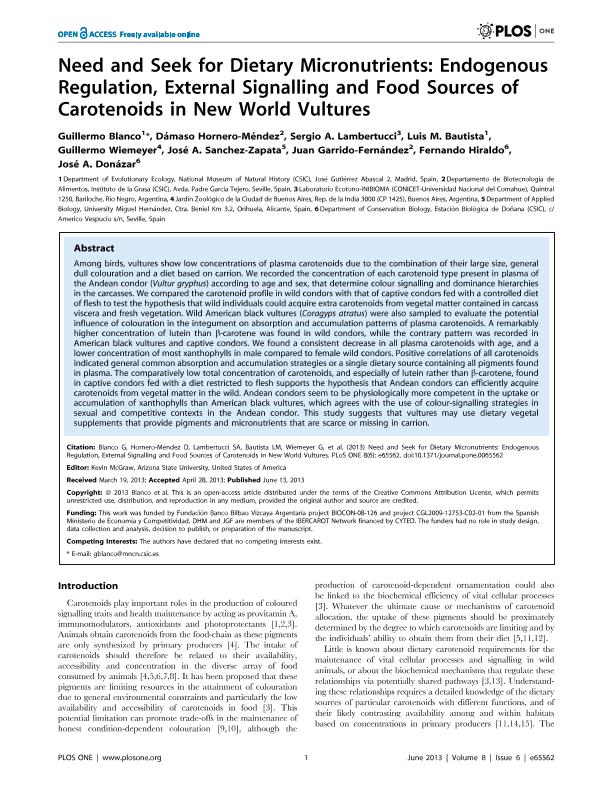Artículo
Need and Seek for Dietary Micronutrients: Endogenous Regulation, External Signalling and Food Sources of Carotenoids in New World Vultures
Blanco, Guillermo; Hornero Méndez, Dámaso; Lambertucci, Sergio Agustin ; Bautista, Luis M.; Wiemeyer, Guillermo; Sanchez Zapata, José A.; Garrido Fernández, Juan; Hiraldo, Fernando; Donázar, José A.
; Bautista, Luis M.; Wiemeyer, Guillermo; Sanchez Zapata, José A.; Garrido Fernández, Juan; Hiraldo, Fernando; Donázar, José A.
 ; Bautista, Luis M.; Wiemeyer, Guillermo; Sanchez Zapata, José A.; Garrido Fernández, Juan; Hiraldo, Fernando; Donázar, José A.
; Bautista, Luis M.; Wiemeyer, Guillermo; Sanchez Zapata, José A.; Garrido Fernández, Juan; Hiraldo, Fernando; Donázar, José A.
Fecha de publicación:
13/06/2013
Editorial:
Public Library of Science
Revista:
Plos One
ISSN:
1932-6203
Idioma:
Inglés
Tipo de recurso:
Artículo publicado
Clasificación temática:
Resumen
Among birds, vultures show low concentrations of plasma carotenoids due to the combination of their large size, general dull colouration and a diet based on carrion. We recorded the concentration of each carotenoid type present in plasma of the Andean condor (Vultur gryphus) according to age and sex, that determine colour signalling and dominance hierarchies in the carcasses. We compared the carotenoid profile in wild condors with that of captive condors fed with a controlled diet of flesh to test the hypothesis that wild individuals could acquire extra carotenoids from vegetal matter contained in carcass viscera and fresh vegetation. Wild American black vultures (Coragyps atratus) were also sampled to evaluate the potential influence of colouration in the integument on absorption and accumulation patterns of plasma carotenoids. A remarkably higher concentration of lutein than β-carotene was found in wild condors, while the contrary pattern was recorded in American black vultures and captive condors. We found a consistent decrease in all plasma carotenoids with age, and a lower concentration of most xanthophylls in male compared to female wild condors. Positive correlations of all carotenoids indicated general common absorption and accumulation strategies or a single dietary source containing all pigments found in plasma. The comparatively low total concentration of carotenoids, and especially of lutein rather than β-carotene, found in captive condors fed with a diet restricted to flesh supports the hypothesis that Andean condors can efficiently acquire carotenoids from vegetal matter in the wild. Andean condors seem to be physiologically more competent in the uptake or accumulation of xanthophylls than American black vultures, which agrees with the use of colour-signalling strategies in sexual and competitive contexts in the Andean condor. This study suggests that vultures may use dietary vegetal supplements that provide pigments and micronutrients that are scarce or missing in carrion.
Palabras clave:
Cathartidae
,
Carotenoids
,
Colouration
,
Signals
Archivos asociados
Licencia
Identificadores
Colecciones
Articulos(INIBIOMA)
Articulos de INST. DE INVEST.EN BIODIVERSIDAD Y MEDIOAMBIENTE
Articulos de INST. DE INVEST.EN BIODIVERSIDAD Y MEDIOAMBIENTE
Citación
Blanco, Guillermo; Hornero Méndez, Dámaso; Lambertucci, Sergio Agustin; Bautista, Luis M.; Wiemeyer, Guillermo; et al.; Need and Seek for Dietary Micronutrients: Endogenous Regulation, External Signalling and Food Sources of Carotenoids in New World Vultures; Public Library of Science; Plos One; 8; 6; 13-6-2013; 1-11; e65562
Compartir
Altmétricas



